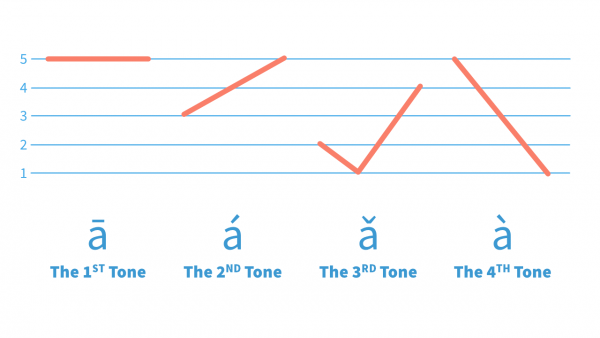Tone Lesson 2 – The First Tone with Tone Pair Drills

CHINESE BASIC TONES: PRACTICE MANDARIN PINYIN FIRST TONE WITH TONE PAIRS
Starting from this lesson, we will be practicing the four Chinese Basic Tones. Today we will focus on the Mandarin Pinyin First Tone. We’ve designed more than enough of Mandarin Chinese Tone Pairs for you to practice and master the First Tone. By practicing different Chinese Tones in combination, you can speak in a natural continuous flow and sounds native.
The Four Chinese Basic Tones
Speaking with the following Tones individually cannot be easier. The difficult part is speaking with different Chinese Tones in combination. That is why we'll be doing Tone Pairs drills and sentence drills in this video.

Mandarin Pinyin First Tone
Mandarin Pinyin First Tone is called 一声 (yī shēng) in Chinese, literally meaning "the first sound". It starts high and maintain the same high pitch the whole process. So it sounds high and flat. That is why it is also known as "The High Level Tone".

Why Do We Practice With Mandarin Chinese Tone Pairs
In Chinese, the vast majority of words are 2-syllable words, which we could also call, 2-character words, 双音节词(shuāng yīn jié cí). Practicing Mandarin Chinese Tone pairs can prepare us well for speaking long sentences and having conversations. In today's lesson, we will be practicing the Mandarin Pinyin First Tone with many Mandarin Chinese Tone Pairs and a few sentences with different Chinese Tones in combination.
| PINYIN | CHINESE | ENGLISH | |
|---|---|---|---|
| 1-syllable Word | wǒ | 我 | I; me |
| 2-syllable Word | zhōng guó | 中国 | China |
| 3-syllable Word | qiǎo kè lì | 巧克力 | chocolate |
| 4-syllable Word | luó màn dì kè | 罗曼蒂克 | romantic |
Mandarin Chinese Tone Pairs Pronunciation Tips
When we pronounce 2-syllable words, there is no long pause between the two syllables. When you speak with Mandarin Chinese Tone Pairs, speak both syllables in one single breath, using the rest of your breath to say the second syllable.Sometimes in a Chinese word, there can be 3, 4 or even more syllables. No matter how many Chinese tones in combination, we usually try to speak them with one single breath.
Mandarin Pinyin First Tone Pronunciation Drills
FIRST TONE + SECOND TONE
| MANDARIN CHINESE TONE PAIRS | ||
|---|---|---|
| PINYIN | CHINESE | ENGLISH |
| zhōng guó | 中国 | China |
| zhōng wén | 中文 | Chinese |
| bāng máng | 帮忙 | to help |
| kōng tiáo | 空调 | air conditioner |
| gōng yuán | 公园 | park |
| SENTENCE | ||
| zhōng guó rén shuō zhōng wén | ||
| 中国人说中文。 | ||
| Chinese people speak Chinese. | ||
FIRST TONE + THIRD TONE
| MANDARIN CHINESE TONE PAIRS | ||
|---|---|---|
| PINYIN | CHINESE | ENGLISH |
| hē shuǐ | 喝水 | to drink water |
| yīng yǔ | 英语 | English language |
| zhōng wǔ | 中午 | noon |
| duō shǎo | 多少 | how many; how much |
| jīng lǐ | 经理 | manager |
| SENTENCE | ||
| jīng lǐ zhōng wǔ hē shuǐ | ||
| 经理中午喝水。 | ||
| The manager drinks water at noon. | ||
FIRST TONE + FOURTH TONE
| MANDARIN CHINESE TONE PAIRS | ||
|---|---|---|
| PINYIN | CHINESE | ENGLISH |
| gōng zuò | 工作 | to work |
| tiān qì | 天气 | weather |
| zhōu mò | 周末 | weekend |
| gāo xìng | 高兴 | happy |
| shēng rì | 生日 | birthday |
| SENTENCE | ||
| tā zhōu mò gōng zuò | ||
| 他周末工作。 | ||
| He works on the weekend. | ||
One tip I found useful is in addition to following along and repeating the words, humming the sounds is also a great way to get how the pairs sound together. I think practicing pronunciation is great too, but if you’re stuck on getting the sound right, try that!
Hi Lili & Dave,
Great course! However, it took me a while to understand how much repetion it would take to master these tones.
Please consider putting a big bold notice at the begining of this course which says something like: “Chinese tone work has a lot in common with the way we learn to play the piano. You just have to play the scales repeatedly until you master them. Plan on lots of repetion!”
Again, great course. Thank you1
Hi Lili,
Thanks for your great course. As a newbie I find it difficult to tell the difference between tone 2 and tone 4 – I can pick tone 1 and 3 well. Do you have any suggestions – I keep practicing but just curious if you have and other things I can do?? Thanks 🙂
This is a very helpful one. Thank you so much. I need more practice. I am still confused.
reference RE in zhōng guó rén shuō zhōng wén sentence.
Which way to say R please? different regions say R as in your way, which is most similar to western way of saying and other regions say as in J ( french pronounciation) or , as in ‘Ju’dge.
many thanks
Oh man, this will definitely take some time to get used to. 2nd and 3rd tone are kinda tricky, as they both get higher in the end, should pay attention to tone duration I guess.
I have a little bit of trouble quickly pronouncing the longer quotes for combining the tones, such as zhongguo ren shuo zhongwen. I need a little bit of help in regards to that.
xie xie ni nice and clear,3rd tone can be low and flat also
Yes the half Third Tone is explained in these two lessons
and
Thank you for such in-depth explanations!
I was disappointed that the 1 1 combo as in 一声 (yī shēng) was left out of the tone pairs, particularly as I find it confusing that some Chinese do the two at the same pitch, others lower and higher, and still others higher and lower. Maybe it does not matter, but I am confused at this point. 🙂
Hi I’m glad you noticed the differences when people speak. We did include repetition of 4th Tone + 4th Tone and 3rd Tone + 3rd Tone, because the Tone changes in these two combinations are commonly shared by the majority of native speakers and they are linguistically recognized. This means that if we don’t speak with the Tone changes for these two combinations, then the pronunciation would be considered not standard or off. But with 1st Tone + 1st Tone and 2nd Tone + 2nd Tone, there is no linguistically recognized Tone change, so if we speak without any Tone change, it is correct and standard. Also tones of characters and words can be affected by the intonation of sentences, whether it is a declarative sentence or question, or an imperative sentence affects the pronunciation of words.
Yeah. Sorry for butting in. I have to agree with your last sentence. I think this is what’s making it baffling to me.
I don’t know er sheng